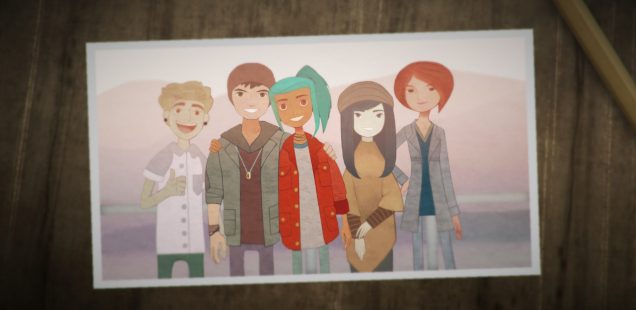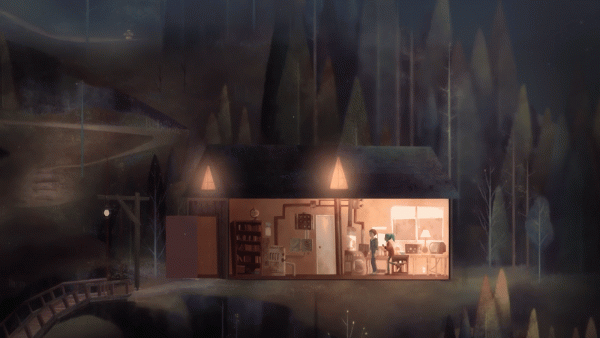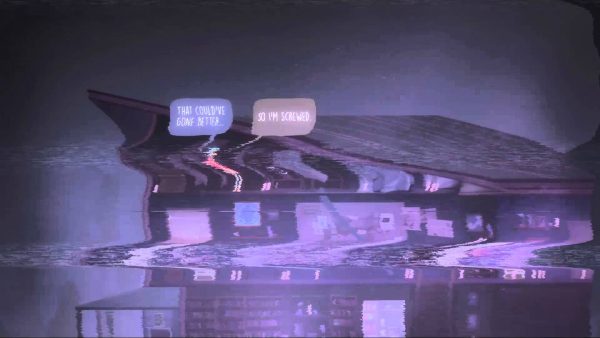
Opened World: Nostalgia Ultra
Miguel Penabella knows the owls are not what they seem.
Nothing captures the feeling of time moving like a late night gathering of friends, whether huddled around a beach bonfire or under stars at a national park or even just sipping beers on a backyard patio scored to a symphony of crickets. The meandering conversation and reminiscing during these long nights are often formative moments where people come to grow as individuals. The best nights stretch well into the early morning, lasting up until the break of dawn and culminating with a hearty breakfast at a 24-hour diner. As teenagers, these easygoing gatherings take on forms that have passed from mere cliché and into the realm of myth: the bittersweet final night before everyone separates for college, the prodigal reunion of friends who have grown apart over the years, the unspoken romance shyly emerging after dark. To look back at these times is a form of nostalgia; we recall our past lives of deepened friendships and blissful idleness devoid of any and all obligation.
Night School Studio’s 2016 game Oxenfree is one such effort to capture that profound sense of nostalgia and coming-of-age teenage growth. Simply rendering a work in colorful pixel art is the typical shorthand for videogame nostalgia, but Oxenfree stands apart with an even richer visual design and evocative storyline that synthesizes such hallowed coming-of-age tales as Stand By Me, The Breakfast Club, Freaks and Geeks, and the recently venerated Stranger Things. The dialogue-driven adventure game also draws from the supernatural, shaping a ghostly mythos not unlike an episode of The X-Files crossed with the warped VHS aesthetic of Poltergeist or the John Carpenter-evoking wonders of It Follows. Moreover, it’s a game partly defined by its chilly fall setting and the accompanying autumnal thickets, cozy sweaters, and after school getaways. I’ve written about the overdetermined meaning of the fall season before, in which storylines bring together teenagers united by the American school calendar and motivated by Halloween mischief. Oxenfree looks backward, both cherishing the emotional weight of a teenage party on the cusp of adulthood and worrying about the reality that soon these characters will all separate each into their own disparate lives in the years to come.
Like other coming-of-age “last hurrah” adventures including Ferris Bueller’s Day Off or Superbad, Oxenfree maintains a delicate atmosphere of apprehension, the lingering disquiet of friends who know that this may be the last time they have together before moving out from high school. The promise of renewal after graduation and the fear of division and growing apart sit awkward and unspoken next to each other. Oxenfree centers on the protagonist Alex, who with recently met stepbrother Jonas and longtime childhood buddy Ren journeys by ferry to the spooky Edwards Island for an overnight beach party. They are later joined by fellow high school friends Nona and Clarissa, leading to teenage gossip and indiscretions, and later to the inadvertent encounter with the island’s supernatural designs interwoven with its cryptic history. Alex is considering leaving her hometown for college, and thus the beachside party serves as a sentimental event meant to reunite old friends and communally anticipate the excitements and anxieties of great change. Coming-of-age stories are concerned with the progression of time, and characters fondly reminisce about the past in order to calcify intimate memories as they mature and move outward, strategically picking out formative events to be remembered.
Finding kinship with Life is Strange, a similarly supernatural-inflected teenage mystery set in the Pacific Northwest, Oxenfree depicts the haziness of memory with game artist Heather Gross’s expressive natural backdrops and earthy colors filtered through a blanket of fog. Like a half-remembered dream, Oxenfree unfolds in a twilit island hideaway devoid of other human beings and engulfed in verdant forests seemingly grown out of the saplings of those in Twin Peaks. The game appears outside of contemporary time, where mom and pop stores with kitschy wooden storefronts line the seaside in some unhurried past. Much of the game resembles a dream; aside from opaque flashbacks in danger of evaporating into thin air like a faint memory, Oxenfree transpires over a long night under a darkened sky spangled with stars. Characters slip in and out of dream states, swap warm memories, and saunter involuntary as if in a sleepwalker’s trance. Moreover, much of the game plays out in extreme long shot, in which the windswept environments totally dwarf the characters and distance them from closer identification. Only the smaller identifying characteristics stand out amidst the imposing landscape: the shock of the Chloe Price/Coraline-esque blue hair of Alex, the orange coat of Nona, or the bushy blond hair of Ren.

In addition to a staggering landscape, Oxenfree also provides a cryptic mystery well beyond these five teenagers’ comprehension. Edwards Island is a deeply evocative space loaded with history and memory; petrified trees and dilapidated ruins from another time suggest layers of the past waiting to be remembered. Indeed, memory remains one of the central themes of the game, because when Alex and Jonas stumble upon an interdimensional temporal tear in reality from within a seaside cave, communications seemingly from the past seep through to the present and demand to be heard. As these characters navigate through the abandoned buildings of the island to uncover clues of its past, hidden intimations of classified military experiments, derelict mining shafts, atomic age nuclear bunkers, and spectral premonitions play into a broader project of rediscovering buried memories. Like ghosts, memories linger in spaces long after they’ve gone.
Oxenfree also gazes backward with an emphasis on interacting with dated, analog technology as a key to engaging with the past. Characters acknowledge early into the game that their mobile phones will not have reception on the remote Edwards Island, compelling them instead to utilize the old world technology on the island when they inevitably get lost. Alex’s portable radio is a nostalgic device that allows her to tune into oldies music and news programs seemingly broadcast from another dimension. Players are coerced to tune the radio and locate the right frequency instead of simply hitting a button to automatically tune to the right station, thus making a minigame out of retro equipment. Moreover, the portable radio’s ability to communicate with the phantom figures of the island produces a tinny, static-y sound when tuned to the right frequency at the right location, conveying wonderfully analog sounds of mechanical crackle and guttural groan. Characters also project old film reels and snap Polaroid pictures, representing physical documentations of moments in time and ways to access the memory of a time and place. By also using analog tools like communications tower radios and maps, Oxenfree lends itself to the nostalgia of backyard adventures where backpacks are stuffed with walkie-talkies and the night ends in campfire s’mores. Indeed, Alex even voices how “This is like a mystery novel” and expresses great excitement at the prospect of a scavenger hunt, reminding players of the childlike sense of play inherent to the storyline and lovingly recalling the thrill of exploring the outdoors with childhood friends.
Nostalgia for throwback technology also extends to the reflexive, fourth-wall breaking narrative ruptures throughout the game. Oxenfree falls under the purview of “VHS horror games,” in which the grainy, fuzzy degradation of the format’s physical tapes manifest in the game’s corrupted visuals. The game plays on established fears of outdated—and therefore “dead”—media, in which videotapes are mapped with unclear memories like the cursed footage of The Ring or the revelatory video at the emotional climax of Silent Hill 2. When encountering the supernatural horrors of the game, Oxenfree will sometimes glitch with static-y, crackling footage like a damaged tape and literally rewind to an earlier point in the scene. This repetition of a scene over and over again with slight variation each time evokes a ghostly, parallel world of interdimensional horrors. Like the suburban encounter with the supernatural “upside down” of Stranger Things, Oxenfree plays upon audience nostalgia for Halloween mischief and childhood horror media common to the VHS tapes that lined the racks of video rental stores before the advent of streaming media. Moreover, the game also taps into memories of radio programs, suggesting a further generational nostalgia when Jonas recalls how his mom used to listen to similar shows after Alex tunes to an old-fashioned broadcast on her radio. The sinisterly peppy radio announcer who recurs throughout the game breaks the fourth wall and speaks in riddles to the characters, evoking the diabolical “quiz show” sequence in the hospital elevator of Silent Hill 2, in which vestiges of the past seem to communicate with the present and the ghosts of the dead uncannily reappear through outdated technology.
The ghosts that surround the characters of Oxenfree can manifest as sweet memories in addition to haunting specters. Alex’s brother Michael recently died, as well as Jonas’s mother, and they carry this grief throughout the game with a palpable sense of hurt. Thus, beneath the cryptic radio transmissions and tears in reality, Oxenfree is ultimately about reckoning with loss. Alex and Jonas both work through their sadness by accompanying one another throughout their travails, growing closer as step-siblings and returning to hidden memories to express things that were left unsaid. These characters grapple with a tension between past and future, and they must negotiate the comforts and safety of family life at home with the beckoning possibilities of a future beyond high school. Worry over the future looms heavily over the proceedings. Ren fears losing his friend Alex if she moves far away for college, and such insecurities manifest when the group frequently splits up, suggesting the feeling of childhood friendship dissipating beyond one’s control.

Ultimately, Oxenfree admits that nostalgia for the past is only a temporary reprieve to life’s problems, and that the past is already history despite efforts to change it. The ghosts of the game tell Alex, “You can’t change before. You can’t change anything,” words that she needs to hear to reach a sense of closure. Like Life is Strange before it, we’re merely spectators to the flow of time. We “take notice of what you choose to” and clutch at moments like an overnight party. By doing so, time hangs in the air before we must accept the need to part our own ways and create new memories elsewhere. The odd events that occur over the course of a single night in Oxenfree bind the five characters together even if they separate after graduation, but it also represents a period of personal growth that will fundamentally change their temperament and worldviews to make them better people. Friendships deepen and young love can even blossom in the game, and the bravura ability to simply hug each individual character before the game’s finale is a kindhearted, empathetic gesture so rarely seen in gameplay mechanics. It reminds us of the significance of childhood bonds and togetherness. These characters may not know it yet, but soon, this night will be looked upon nostalgically too.
What Night School Studio accomplishes with Oxenfree is tapping into the collective memories of youthful leisure and possibility, where simply exploring a backyard wilderness is grounds for profound character growth. Whether through the sublime soundtrack by scntfc that revives the synthesized downtempo ambiance of Boards of Canada and Tangerine Dream or the narrative familiarity of a John Hughes-esque collection of teenagers unsure about their place in the world, Oxenfree reflects back the anxieties and life lessons encountered throughout these formative nights. Fear of the unknown is universal, but so too is sublimity; solitude can be found simply in sitting by the fire and remembering.
Miguel Penabella is a freelancer and comparative literature academic who worships at the temple of cinema but occasionally bears libations to videogames. His written offerings can be found on PopMatters, First Person Scholar, and Unwinnable, and he blogs on Invalid Memory.